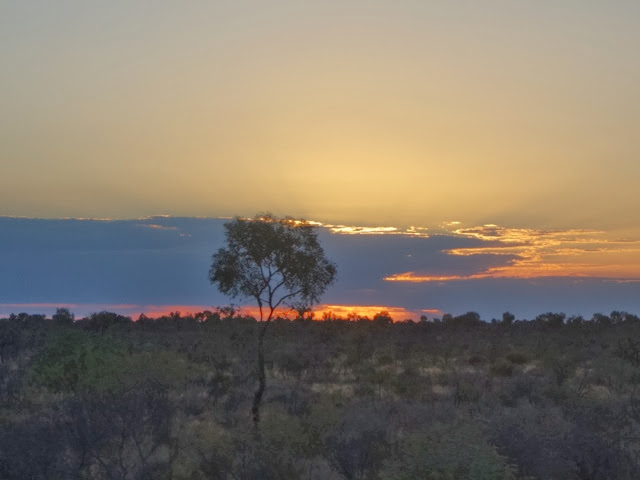I'd booked my ticket in Bali a little over a week before. Normally the train runs twice a week, but over the Christmas period, there was only one service, this meant I had to wait in Darwin for a little longer any travel advisor would recommend, and also that I would be denied a three day stop at Alice Springs to see more of the outback. Nevertheless, I booked and made my way to the train station on Wednesday morning. It should be noted that although they announced that the line terminates at Darwin, it doesn't. In fact it stops some 28km south of the city, so it's necessary to get a coach transfer from the city centre to the terminus, which itself costs $15. Mind you the train is so very long, that it would be impossible to station it within the downtown area.
Most of the twenty carriages of the train are given over to Platinum and Gold class cabins. At the front of the train are two cars for Red class, these are filled with reclining seats and are the most economical way of travelling on the train. I paid $431 Aus for a non-transferable ticket. There used to be a red class sleeper car, but this was discontinued. As it happens, all the Platinum and Gold cabins were sold anyway, they tend to be booked well in advance by retired couples on an adventure. I was told by a conductor that the cheaper red tickets are the most difficult to sell. Perhaps some people are dissuaded by the idea of 50hrs on a seat, but not me.
This is one of the red cars. There's plenty of legroom, and the wide seats recline a lot further back than on an aeroplane; they can also rotate 180° if you want to face your neighbour.

A typical view from the train at the top-end of the Northern Territory. Bush, boulders and termite mounds.
Over the journey southwards, the train makes two longer scheduled stops. The first just a few hours out of Darwin is at Katherine. Gold and Plantinum customers have a variety of tours available included in their ticket price or for additional supplements. If there are any places still available on these tours, they are then offered to those of us in the cheap seats at full price. With nothing better to do, I signed up to the afternoon boat tour on the Katherine River which cost me $117 extra dollars. There's nothing like a captive audience for pushing up revenues.
It was the start of the rainy season, but the river level was still not high enough to allow a single boat trip up the river. Instead, when the river became too shallow for our first boat, we moored and walked upstream along the banks to the next awaiting boat to take us a stage further.
Even this far in-land we saw esturine crocodiles lurking at the edge of the river, waiting for their next meal to wander blindly into their unmarked territory.
Here's an aboriginal rock painting above the high water mark. It's also somewhat higher than anyone can reach, quite how the artist painted up there remains the source of speculation. Eucalyptus scaffolding was what I posited.
Back on the train, this is the Matilda restaurant car where we Red service passengers were allowed to sample the delights of the Ghan's meal service, or just enjoy a beer or wine as the passing land changed slowly from verdant green to rust red.

Sunrises and sunsets out in the desert are pretty spectacular, there's very little in the way of trees to break the unending horizon.
One is really impressed with a sense of isolation, despite being surrounded by other punters. The train for just a few minutes twice a week, is almost the only human presence in this enormous extraordinary expanse of red desert. Though many of us were barely there at all, mostly dozing, glimpsing the unfolding landscape through a drowsy dreamtime.
Why is it called The Ghan? In the early years of colonial pioneering, various brave men set out from the southern cities to find a path to the northern coast. After many failed and sometimes fatal attempts, a transcontinental route was found and a telegraph line was built, cutting communication time between England and Australia from a few weeks, to a few minutes. All of these exploratory missions across the burning heart of the country were supported by camels imported to Australia from Afghanistan, hence, Ghan. Many of their Afghan handlers stayed and married with european colonials and indigenous peoples, and their presence is still very discernible.
On the second day, after leaving Alice Springs, things started to heat up. We noticed a rather flustered looking engineer marching up and down between the carriages. Summer is always hot in the red centre of Australia, but apparently things were getting freakily scorching outside, and the air conditioning was at breaking point - she cannae take it anymore Captn. A whisper went round that the thermometer on the outside had reached 55°C ! The right side of the train, facing the sun, was actually too hot to touch, and everyone moved across to the seats in the left. The head conductor came through, apologising and confirming the astonishing out door temperatures. It was quite a contrast from the Trans-Siberian permafrost.
Between Darwin and Alice, there were many spare seats which allowed us to stretch out in comfort. even after Alice Springs, where we picked up several more passengers, I managed to have a pair of seats to myself. I could have stayed on the train for much longer, but arriving in Adelaide at lunch time on the third day, I was keen to get into town and find somewhere to stay.
Here's a little collage made up from views through the vestibule window across the 50 hour trip.

































































